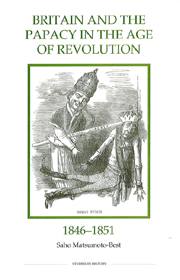Book contents
- Frontmatter
- Contents
- Dedication
- List of illustrations
- Acknowledgements
- Abbreviations
- Introduction
- 1 From 1815 to the election of Pius IX
- 2 The pope's liberal reforms, 1846–1847
- 3 The origins of the Minto mission
- 4 Britain and the 1848 revolution in Rome
- 5 Britain and the rise and fall of the Roman republic
- 6 The restoration of the Catholic hierarchy and anti-Catholicism in Britain
- Conclusion
- Bibliography
- Index
3 - The origins of the Minto mission
Published online by Cambridge University Press: 12 September 2012
- Frontmatter
- Contents
- Dedication
- List of illustrations
- Acknowledgements
- Abbreviations
- Introduction
- 1 From 1815 to the election of Pius IX
- 2 The pope's liberal reforms, 1846–1847
- 3 The origins of the Minto mission
- 4 Britain and the 1848 revolution in Rome
- 5 Britain and the rise and fall of the Roman republic
- 6 The restoration of the Catholic hierarchy and anti-Catholicism in Britain
- Conclusion
- Bibliography
- Index
Summary
Faced with the mounting crisis in the Italian peninsula in the late summer of 1847 the response of the British government was to decide to send the lord privy seal, Lord Minto, to visit the Italian states. At first glance it might appear that this decision can be explained solely by reference to British interests in Italy and the threat posed by the fear of revolution and of possible Austrian and French intervention. This motive clearly did exist and was very significant; after all the peace of Europe was at stake. However, there were also other reasons for the despatch of Lord Minto, for the summer of 1847 saw the convergence of a number of disparate factors that made the idea of a mission to Rome very attractive. These other factors, namely Britain's continuing desire to use the papacy to legitimate its policies towards Ireland and control the Irish clergy, and the debate over the re-establishment of the English Catholic hierarchy, were concerned not with the fortunes of Italian nationalism and the Austrian threat to the pope's temporal power, but rather with the ecclesiastical side of papal affairs. It is only by looking at all of these areas that an understanding of how and why the Minto mission took place may be reached.
Minto and the Austrian threat to Italy
The origins of the Minto mission and its intended goals have been a matter of debate ever since its inception.
- Type
- Chapter
- Information
- Publisher: Boydell & BrewerPrint publication year: 2003



